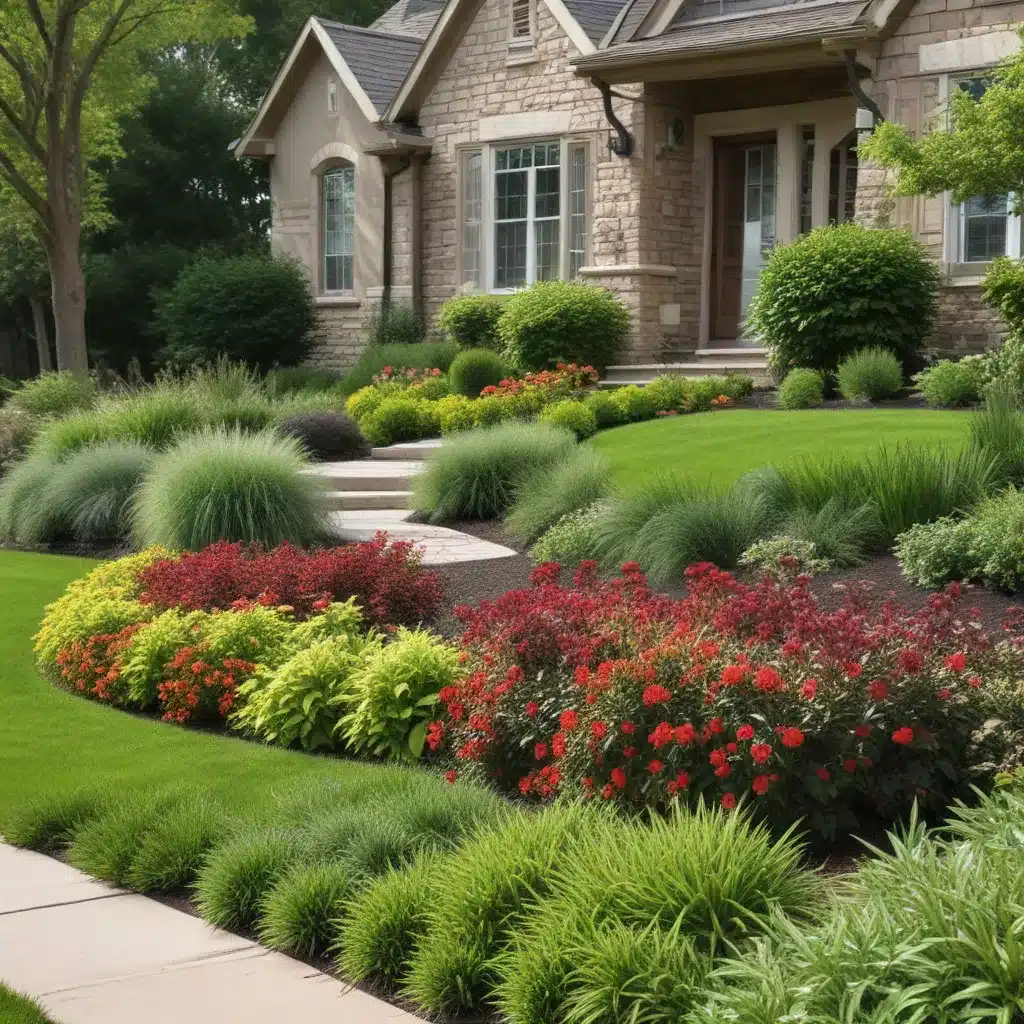
As an experienced home improvement consultant, I’ve witnessed a growing demand for sustainable landscaping solutions that not only enhance a property’s curb appeal but also contribute to environmental responsibility. In this comprehensive guide, we’ll explore the latest trends in eco-friendly outdoor design, offering practical insights to help you transform your home’s exterior into a showcase of beauty and sustainability.
Eco-Friendly Design Principles
At the heart of sustainable landscaping lies a deep respect for the natural environment. By embracing native plant selection, water conservation strategies, and organic pest management, homeowners can create lush, visually appealing landscapes that are in harmony with the local ecosystem.
Native Plants: One of the cornerstones of sustainable landscaping is the use of native plant species. These plants, which are indigenous to your particular region, are naturally adapted to the local climate and soil conditions, requiring less water and maintenance than non-native varieties. By incorporating native flora, you can reduce your environmental footprint while also attracting beneficial pollinators, such as bees and butterflies, to your garden.
Water Conservation: Water scarcity is a growing concern, and sustainable landscaping offers solutions to address this challenge. Xeriscaping, a technique that utilizes drought-resistant plants and efficient irrigation systems, can significantly reduce water consumption without compromising the aesthetics of your outdoor spaces. Homeowners can also consider rainwater harvesting systems, which collect and store precipitation for landscape irrigation, further minimizing the demand on municipal water supplies.
Organic Pest Management: Traditional landscaping often relies on synthetic pesticides and herbicides, which can have detrimental effects on the environment and human health. Sustainable gardeners, on the other hand, embrace organic pest control methods, such as encouraging natural predators, using companion planting, and applying natural, non-toxic repellents. This approach not only protects the ecosystem but also ensures the long-term health and vibrancy of your outdoor spaces.
Landscape Aesthetics
While sustainability is a primary focus, sustainable landscaping also offers a wealth of design possibilities that can enhance the visual appeal of your property. From low-maintenance hardscaping to pollinator-friendly gardens and multifunctional outdoor living areas, these trends cater to the evolving needs and preferences of modern homeowners.
Low-Maintenance Hardscaping: Hardscaping, such as patios, walkways, and retaining walls, plays a crucial role in sustainable landscaping. By opting for permeable pavers, decomposed granite, or natural stone, homeowners can create durable, low-maintenance outdoor surfaces that allow rainwater to percolate into the ground, reducing runoff and promoting groundwater recharge.
Pollinator-Friendly Gardens: Incorporating plants that attract bees, butterflies, and other beneficial insects is not only ecologically responsible but also visually captivating. Homeowners can curate vibrant, pollinator-friendly gardens that showcase a diverse array of blooms, providing food and habitat for these vital pollinators while enhancing the overall aesthetic appeal of their outdoor spaces.
Multifunctional Outdoor Spaces: Sustainable landscaping also embraces the concept of multifunctionality, where outdoor areas serve various purposes beyond mere decoration. This can include creating integrated seating areas, kitchen gardens, or shaded retreats that blend seamlessly with the surrounding landscape, offering homeowners and their families versatile spaces for relaxation, entertainment, and connection with nature.
Sustainable Materials and Practices
Sustainable landscaping goes beyond plant selection and water conservation; it also involves the thoughtful use of materials and the implementation of eco-friendly practices throughout the design and maintenance process.
Recycled and Renewable Resources: Homeowners can explore the use of recycled materials, such as reclaimed wood or repurposed concrete, in their landscaping projects. Additionally, incorporating renewable resources, like bamboo or natural stone, can contribute to the overall sustainability of the outdoor space while maintaining an aesthetically pleasing appearance.
Energy-Efficient Lighting: Outdoor lighting plays a significant role in enhancing the ambiance and functionality of a landscape. Sustainable landscaping trends favor the use of energy-efficient LED or solar-powered lighting solutions, which not only reduce energy consumption but also minimize the environmental impact of the overall project.
Composting and Soil Health: Healthy soil is the foundation of a thriving, sustainable landscape. Homeowners can embrace composting practices, transforming organic waste into nutrient-rich soil amendments that nourish the plants and reduce the need for synthetic fertilizers. This circular approach to waste management contributes to the long-term vitality of the landscape while aligning with eco-friendly principles.
Curb Appeal Enhancements
Sustainable landscaping is not only about environmental stewardship; it also offers opportunities to enhance a property’s curb appeal, making it more inviting and visually captivating for potential buyers or visitors.
Thoughtful Plant Placement: By strategically placing specimen plants, evergreen shrubs, and flowering annuals along the property’s perimeter, homeowners can create a visually striking first impression that draws the eye and showcases the property’s attention to detail.
Inviting Entryway Features: The entryway to a home is the gateway to the overall landscape, and sustainable landscaping trends emphasize the importance of creating a welcoming atmosphere. Homeowners can incorporate decorative planters, custom-built trellises, or water features to craft an inviting and visually appealing entry point that reflects the property’s commitment to eco-friendly design.
Harmonious Color Schemes: Sustainable landscaping also considers the overall color palette of the outdoor space, harmonizing the various plant varieties, hardscaping elements, and architectural features to create a cohesive and visually appealing aesthetic. By thoughtfully selecting plants with complementary hues and textures, homeowners can craft a landscape that is both aesthetically pleasing and environmentally responsible.
As an experienced home improvement consultant, I’ve witnessed the transformative power of sustainable landscaping. By embracing eco-friendly design principles, homeowners can not only enhance their property’s curb appeal but also contribute to a healthier, more sustainable future. Whether you’re a homeowner looking to refresh your outdoor spaces or a real estate professional seeking to showcase the value of sustainable living, these sustainable landscaping trends offer a wealth of opportunities to create visually stunning and environmentally conscious outdoor environments.
For more inspiration and practical advice on sustainable home improvement projects, be sure to visit Reluctant Renovator, where you’ll find a wealth of resources catered to cost-conscious, eco-minded, and family-oriented renovators like yourself.



